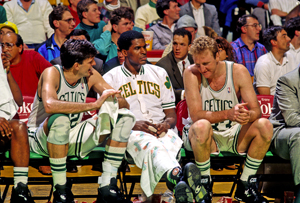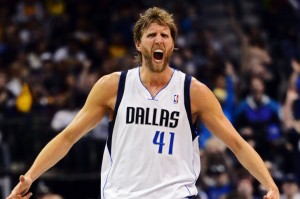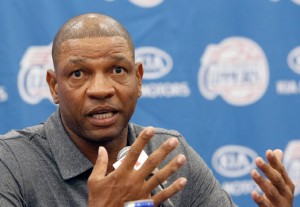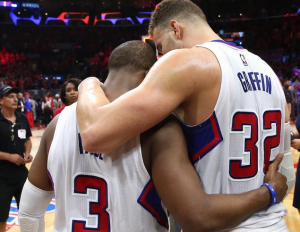 With about two minutes remaining in Saturday night’s Game 7 between the San Antonio Spurs and Los
With about two minutes remaining in Saturday night’s Game 7 between the San Antonio Spurs and Los  Angeles Clippers and still no clear indication regarding which team was moving on and which team was going home, Tim Duncan gave himself a break from the magnitude of the moment and offered some candid perspective.
Angeles Clippers and still no clear indication regarding which team was moving on and which team was going home, Tim Duncan gave himself a break from the magnitude of the moment and offered some candid perspective.
The All-Star forward and face of one of the handful of NBA dynasties approached Doc Rivers, who was in his 12th Game 7 as a coach. With one of the greatest games in league history very much in the balance, Duncan had a brief but telling question.
Duncan asked incredulously, “This is the first round?”
When it was over minutes later – when a clearly hobbled Chris Paul threw in a difficult, off-balance, step-back bank shot over Duncan and Danny Green that gave the Clippers a 111-109 victory and dethroned the champion Spurs – everyone agreed that the teams had just played one of the greatest playoff series of all time.
Some immediately labeled it as the greatest ever, an overreaction which occurs often in this day and age of social media, the 24-hour news cycle and short attention span theatre that should have coordinating producers handing out Ritalin to their pundits before putting them on the air.
There’s no denying that the raw numbers certainly put Clippers-Spurs in the conversation. Over the course of seven games and 341 minutes, the teams were separated by just three points. The road team won four times. Game 7 featured 16 ties and a mind-boggling 31 lead changes.
And it all happened without any “baloney,” as Spurs coach Gregg Popovich said. There was no preening, no rough stuff, no war of words through the press, no shade on Twitter. It was pure, unadulterated basketball at the highest level of effort, skill and competition.
As Russell Crowe once asked in another highly competitive forum, “Are you not entertained?”
 To anoint Clippers-Spurs as the greatest playoff series ever, however, seems a bit dismissive of the past. When the superlative talk began, I was able to rattle off a handful of postseason matchups that were just as good or better.
To anoint Clippers-Spurs as the greatest playoff series ever, however, seems a bit dismissive of the past. When the superlative talk began, I was able to rattle off a handful of postseason matchups that were just as good or better.
There was the 1981 Eastern Conference finals, in which the Boston Celtics rallied from a 3-1 deficit by winning the last three games over the Philadelphia 76ers by a combined seven points. There was the 1988 NBA Finals, where the Los Angeles Lakers were trying to become the first team in a generation to repeat as champions while the upstart Detroit Pistons were becoming the “Bad Boys” and refusing to back down.
There was the 2000 Western Conference finals, in which the Lakers with first-year coach Phil Jackson were on the verge of a historical collapse before staging a frenetic fourth-quarter rally in Game 7 against the Portland Trail Blazers. There was the 2002 Western Conference finals, which saw three road wins and two last-second shots before the Lakers won Game 7 in overtime on the road vs. the Sacramento Kings.
Even the first round – normally a formality in the NBA playoffs – produced a classic as recently as six years ago, when the Celtics outlasted the Chicago Bulls in seven games, four of which went to overtime for a staggering seven extra sessions of bonus basketball.
For my money, the best playoff series I have ever seen was the 2006 Western Conference semifinals between the Spurs and Dallas Mavericks. Five games were one-possession affairs with less than a minute to play. Two went to overtime, including the finale. And the Mavericks avoided the ignominy of blowing a 3-1 lead by winning Game 7 on the road.
That series has plenty in common with Clippers-Spurs. Both series featured a pair of teams with a legitimate chance to win it all. Both series featured the Spurs as defending champions. Both series were capped by extended, highly stressful stretches of crucial possessions, any one of which could determine the outcome. And both were ultimately decided in the final moments of Game 7  by players making defining shots and plays.
by players making defining shots and plays.
But the primary parallel between 2006 Mavs-Spurs and 2015 Clippers-Spurs is their league-wide impact on the postseason itself. Ultimately, both will change how the playoffs are formatted.
When Dallas faced San Antonio in 2006, the three division winners from each conference were guaranteed to receive the top three seeds. Despite winning 60 games, the Mavs finished second to the Spurs in the Southwest Division and were bumped to the fourth seed. That led to some warranted grumbling from ink-stained wretches that the teams with the two best records in the West should not be meeting until the conference finals. But instead of just pointing at the problem, one writer offered a solution.
Mike Monroe of the San Antonio Express-News presented the idea of assuring the division winners a seed no lower than fourth but ordering the conference’s top four teams by record. That would have assured Dallas of the second seed and a showdown with San Antonio in the conference finals.
Commissioner David Stern said during his annual “State of the Game” address at the NBA Finals that he liked that idea. Three months later, the NBA announced the change.
Fast forward to this season, where the West was deeper than the collective works of Shakespeare. Before attrition began taking its toll in March, there were six legitimate title contenders, and that did not include injury-ravaged Oklahoma City, which was still hoping to make a run following the return of reigning MVP Kevin Durant.
But while Portland was securing the Northwest Division and one of the top four seeds, it was losing rotation players on almost a weekly basis. When the dust settled, the Trail Blazers were just one game better than seventh-seeded Dallas, four games worse than San Antonio and five games worse than LA. Memphis was bumped to fifth and San Antonio – by losing on the season’s final day – fell from second to sixth.
 “That’s a flaw,” said Rivers, whose team also didn’t win its division. “I think the divisions are important. They’re nice to have. They’re nice to be celebrated, for some and some not, but I don’t know if they should be celebrated as far as in the standings. I think it’s something that the league will absolutely look at and try to fix.”
“That’s a flaw,” said Rivers, whose team also didn’t win its division. “I think the divisions are important. They’re nice to have. They’re nice to be celebrated, for some and some not, but I don’t know if they should be celebrated as far as in the standings. I think it’s something that the league will absolutely look at and try to fix.”
Rivers also doesn’t like the idea a division winner retains the tiebreaker simply by winning its division.
“Let’s say if we had gone undefeated against a (division-winning) team but our records are tied and they would get home court, that to me is insane,” he said. “That’s worse in some ways to me, because head-to-head should always go first. But there’s flaws and you fix them, and I think the league will look at that.”
It already is. Commissioner Adam Silver has been saying that for some time, discussing a proposal that our Chris Sheridan has strongly advocated as well.
Devaluing the postseason importance of winning the division, as Rivers suggested, is a possibility. So is the notion of doing away with divisions altogether and streamlining the conference, while still taking the top eight teams from each. Perhaps not on the agenda is the novel pitch that came three years ago from Bill Simmons, who suggested filling the eighth seed in each conference with a 16-team single elimination tournament. But it should be.
Silver already has said nothing will change until at least the 2016-17 season. If that is the case, so be it. Clippers-Spurs actually salvaged what otherwise would have been one of the worst first rounds in recent memory, with three sweeps and two teams losing elimination games on their home floors by a combined 78 points. And on arguably the biggest sports day of the year, Game 7 was by far the most compelling event, above the NFL draft, Yankees-Red Sox, the Kentucky Derby and Mayweather-Pacquiao.
“I think people will talk about this one years later,” Clippers guard Jamal Crawford said.
They will, for the same reasons people still talk about Mavs-Spurs in 2006.
For how memorable a series it was.
And for the lasting change it will have on the future of the NBA playoffs.
Chris Bernucca is the managing editor of SheridanHoops.com. His columns appear Monday during the season. You can follow him on Twitter.
